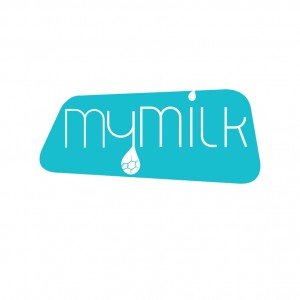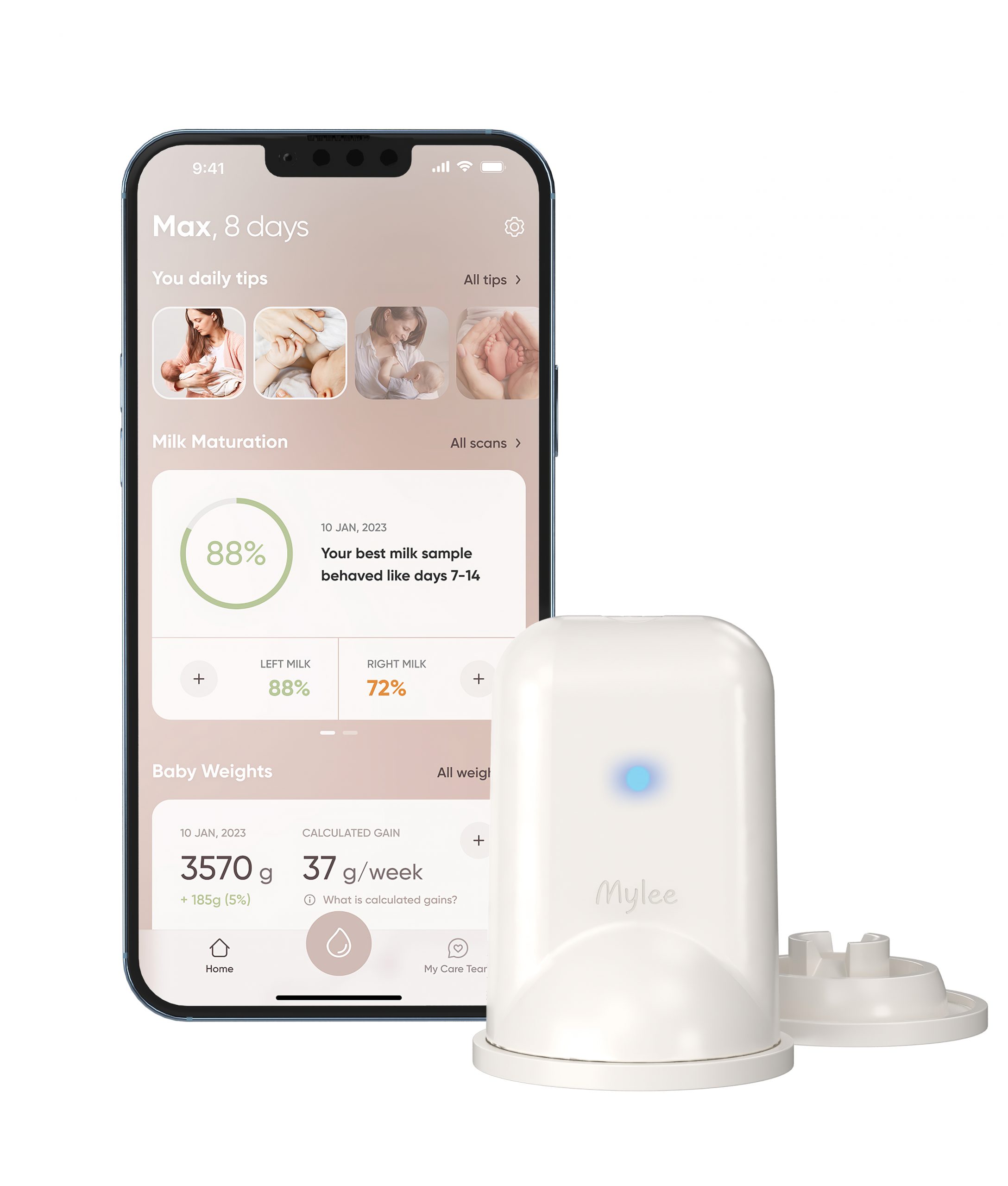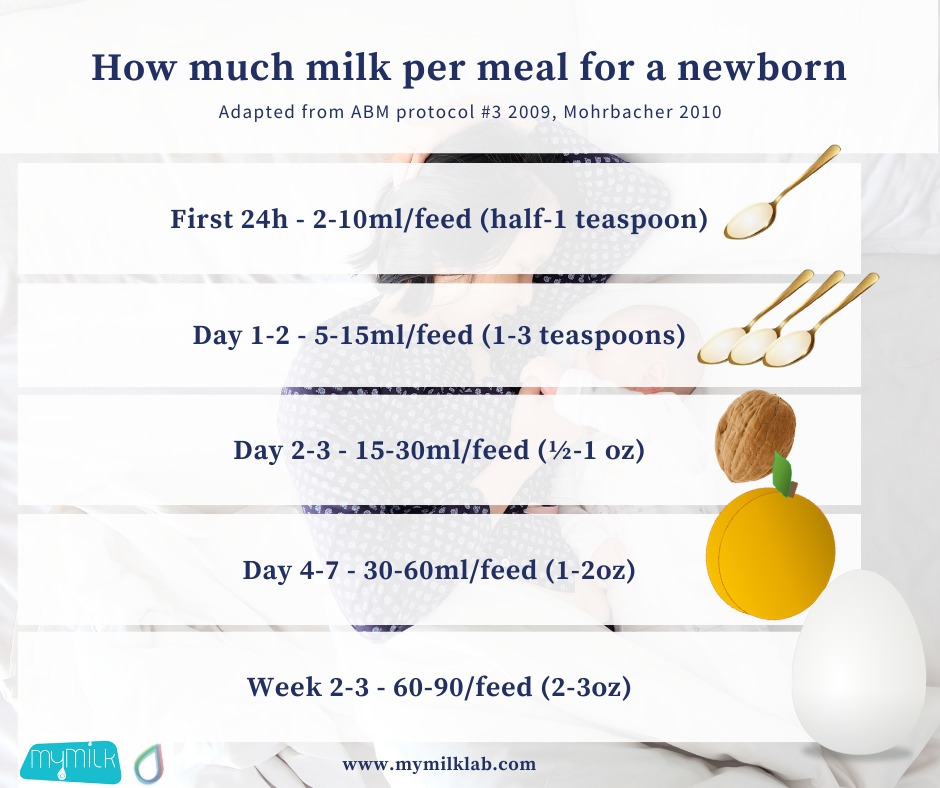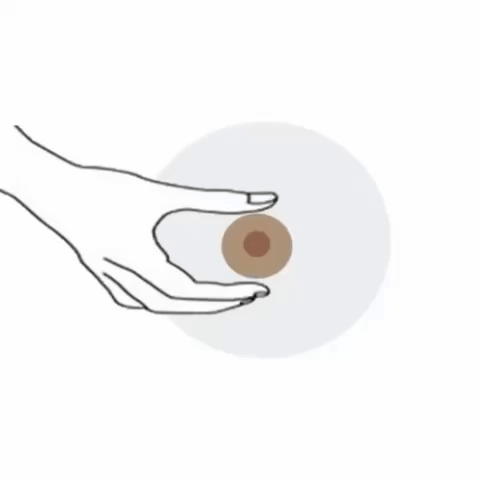

By inserting just several milk drops into the device daily, and app interaction, you can see your day-to-day progress and get personal tips.
The MyLee is in beta testing. You can join!
In the first weeks of breastfeeding, milk is produced in the mother’s breast through a demand and supply mechanism, so that the mother develops the breast infrastructure for milk production and produces milk in accordance with the latch and milk transfer stimulus. But this does not happen over-night, it is a process. Getting breastfeeding established takes a ‘time investment’ and the first days-weeks can be challenging.
We created a series to support your knowledge on breastfeeding establishment for good milk supply- prenatally, in the first days at the hospital, and at home. You can also get the full guide PDF to your mailbox. This part focus on the critical first days period. What to expect and how to set good breastfeeding practices.
Studies show that breastfeeding in the delivery room or as soon as possible contributes greatly to subsequent breastfeeding success.
After a vaginal birth or by caesarean section, your baby is as alert as possible as close as possible to the birth and the suckling reflex is high during the first hour after birth.
Ask to have your baby placed on your body as much as possible, even after a caesarean section, and wait for your baby to show signs of alertness and thus show you that he is ready for the first breastfeeding attempt. She will look for the nipple and then open a big mouth, as a signal to attach her to the breast
Frequent breastfeeding, starting right after birth, is of great importance in creating the abundance of milk for continued breastfeeding. The more you breastfeed in the first few days, the better are your chances to produce milk according to the increasing milk volume demand of the baby.
Seek help often with first breastfeeding attempts. In the delivery room or operating room, ask the midwife for help with skin-to-skin contact, identifying the baby’s readiness to breastfeed and attaching the baby to the breast. The first latch-ons teach the baby and you the breastfeeding technique and signals to your body that your baby is alive and needs you, and are important for the success of breastfeeding later on.
Seek the help of lactation consultant and / or nurses with appropriate training. It is perfectly fine to ask several times for help in attaching the baby to the breast in those first days, this is a technique that sometimes takes time to acquire. You will not always be offered, but it is important to know how to ask proactively. Know that every hospital should have a qualified lactation consultant. Look for her. However, most of the staff have experience in helping mothers with latch techniques, so don’t just wait for someone to offer.
It is a good thing if your baby wants to eat “all the time”. The more your baby is breastfed in the first few days (i.e .: more than 8 times in 24 hours) the greater the chances that she will not lose excessive percentages of weight, and also reduce the chance of developing neonatal jaundice. Do not hesitate to breastfeed your baby whenever she seems interested even if she just finished breastfeeding. Offer the breast often. Breastfeeding sessions can be very long, even an hour long, but can also be very short – a few minutes, and it varies between different mothers, babies, and sessions. It normally takes several weeks for the sessions to shorten and get in some order.
Breast stimulation is helpful in establishing breastfeeding and good milk production. If baby is sleepy, you should add manual milk expressions between breastfeeding attempts.
Place the baby on the breast and / or place the baby skin-to-skin on your chest, belly to belly, wearing only a diaper as often as you can (if it is cool, cover both of your bodies with a blanket).
The baby’s contact with your body and the stimulus of the breast contributes to the success of breastfeeding by increasing the secretion of hormones necessary for the production of milk and the maturation of breast tissue. In addition, when a baby is in skin-to-skin contact with you, the baby will suckle more often and it will be easier for you to identify her signs of hunger and when she is ready for the next breastfeeding already before she cries.
Skin-to-skin contact can be made, even when she is connected to monitors.
If you had a caesarean section, ask for help in a position that will not be painful. You can place a pillow or blanket on the incision area to avoid painful touch.
Staying in the same room with your baby, as close as possible to the birth, increases the chance of a successful breastfeeding initiation and progress. When you have your baby by your side, you can have a truly responsive feeding and not obey to any specific clock. You will be able to respond to the early signs of hunger and your baby will not have to cry. Breastfeeding a calm baby is easier and more pleasant for both mother and baby. Even if the fancy ‘rooming-in’ room in the ward is not available, you have the right to demand that your baby be with you without separation in any room.
If your baby is hospitalized in the NICU, try to stay with her as much as possible, at the same time notify the professional staff that you are interested in breastfeeding and ask to speak with the head of the unit to understand how breastfeeding can be integrated into medical care. There are usually also breastfeeding or pumping rooms / sections next to the NICU. If baby is not directly breastfeeding, ask to provide hand expressed or pumped breast milk and ask for guidance on how to provide milk to the NICU. Know how much milk is expected per feeding at any day after birth.
If for medical reasons your baby can not suckle directly from the breast in the first day or in the first days, milk production should be stimulated frequently, by manual expression and / or pumping at the same frequency a healthy term baby would feed, which is at least every 2-3 hours, including during the night. It may be difficult, but its the only way to signal to your body that this milk is needed. Initially expect only several drops every attempt, and it will take time to express each meal. Volumes will gradually increase as you get familiar with the process and as you keep expressing frequently and effectively. Be patient, and proactive. It pays off.

Wash your body daily after giving birth. If there is sensitivity in the nipples it is recommended to rinse once a day with soapless soap, but not more. The soap can dry the skin and remove the lubricants that the body naturally excretes. Apply pure lanolin ointment in combination with a few drops of milk on the nipples frequently and after each breastfeeding session. This method was found to be effective in preventing wound formation. Be sure to change breast pads when they are soaked or after each breastfeeding and apply lanolin or organic edible oil (such as coconut oil) to prevent the nipple from sticking to the pad. There is no need to wash the nipples before breastfeeding.
In case you feel that there is very high sensitivity in the breast that lasts beyond the first minutes of breastfeeding or in case wounds start to form, contact a lactation professional. It is important to make sure latch is deep and correct in order to prevent hurting the nipple, and promoting effective suckling. If the latch is not deep enough and very painful, gently release the vacuum by inserting your little finger at the side of the baby’s mouth, and attach her again when her mouth is open wide.
Immediately after birth, colostrum will nourish your baby, while your breast undergo the process of transition to producing transitional milk. As part of this process, the breasts fill with fluid and you will feel that they are full and warm. This stage of breast fullness, will be noticeable between day 2-4 after birth.
This fullness is physiological and there is no need to fear that breastfeeding will make it worse, on the contrary, the more you breastfeed in the first few days, the faster your milk will stabilize and the feeling of fullness will pass. Frequent and efficient breast emptying drives milk production at the breast. Moreover, accumulation of milk in the breast can cause engorgement and even inflammation of the breast, so there is great importance to efficient breast emptying.
Offer the baby to breastfeed as much as possible to help you empty the breast. If you cannot breastfeed and the breast feels full, do not hesitate to empty the breast by manual expression or with the help of a pump. In certain cases, a little breast emptying prior to breastfeeding can help the baby hold on to the breast better and prevent sores. Emptying the areola area before breastfeeding so that it is softer and more flexible will help your baby suckle better.
The more you learn to recognize your baby’s early signs of hunger, the easier it will be for both of you. Crying is a late sign of hunger. Early signs of hunger include: when the baby is awake, sucking and licking movements with the mouth, bringing the hands to the mouth, making noises and sounds. When a baby is asleep, rapid movements of the eyes under the eyelids can be noticed when the baby is about to wake up for a meal, and after waking up, stretching and movements of the limbs. When you are near the baby, you will be able to respond to these early signs. Be responsive to your baby’s signs, don’t look at the clock.
Even if your baby was quiet in the bassinet initially as she was exhausted from the delivery process, it is just natural she will prefer to be in contact with you and don’t want to spend any time in the bassinet, and it is normal if she is calm on your body, and calm while nursing.
Unless you have received explicit instruction from a care provider about the need to provide sugar water or formula, it is really not advisable to combine any formula with breastfeeding, especially not early on. Giving any supplement over the milk that you produce will impair the ability of your body to recognize and adjust to your baby’s needs, and will probably harm your ability to produce enough milk. For successful breastfeeding, do not plan in advance to add formula early. You may choose to combo feed at a later point, but for you to be able to maintain any breastfeeding and really be able to choose to breastfeed, it is really advised to avoid any external milk sources in the first weeks.
If for any reason there is a real need to give your baby any alternatives to your breastmilk, and you wish to be able to maintain any or exclusively breastfeeding, it is important to protect milk supply by hand expressing and pumping every time your baby gets any alternative. Don’t just wait for your milk to come, make it arrive.
In the first hours and days after birth (in some cases even before birth) you may need to hand express and collect colostrum for feeding your baby, this may be needed in case of separation between mother and baby, if the baby is sleepy, in late pre-term babies, in cases of low glucose or Jaundice, and after a C section. Hand expressing colostrum and milk in the first couple of days is usually more productive than breast pumping.
But even if you are not separated, hand milk expression between feeds on the first hours and days postpartum was also shown by research to improve milk volumes, enhance milk coming in and improve baby’s weight gain, and improve overall breastfeeding success. Don’t worry about inducing over-supply at this early stage. Take advantage of this great early hack for improved supply.
Hand milk expression is also an efficient way to reduce breast engorgement and prevent milk stasis, therefore helping prevent breast inflammation.
Hand expression done correctly should not be painful. It may take several trials to get comfortable. Don’t expect more than a few drops initially, it is OK! It improves with every drop, and with practice. You got this!
You don’t have to collect all milk drops, hand expression can be done to a cloth, or in the shower, it will not waste milk for your baby, on the contrary, it will help your body to produce enough milk for her needs.


snapshoot from MyMilk breastfeeding guide
Link to educational video by Dr. Jane Morton From Stanford Medicine – BREASTFEEDING IN THE FIRST HOUR VIDEO